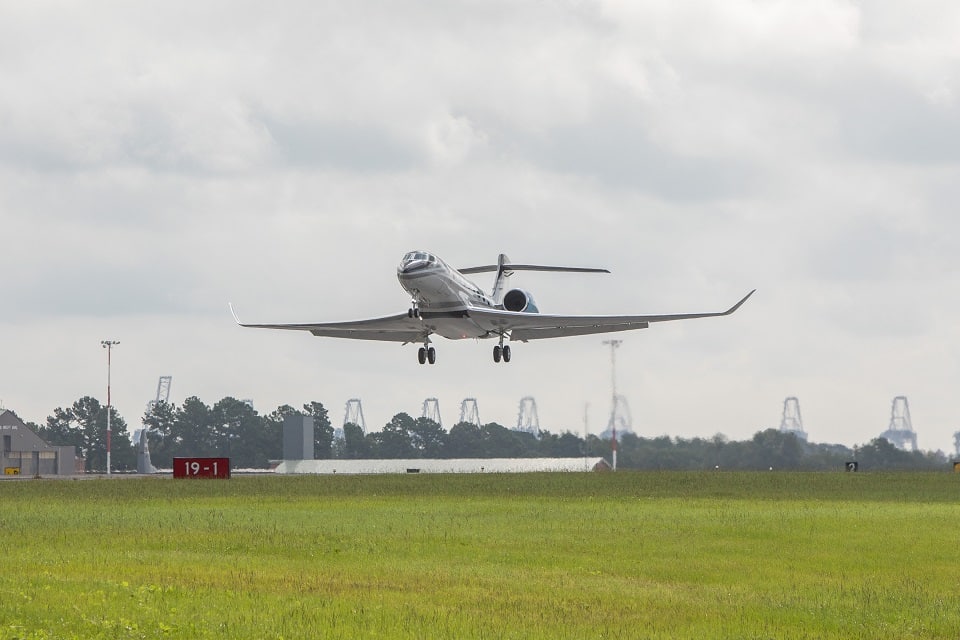Airlines
Second Gulfstream G800 test aircraft completes first flight

The second Gulfstream G800 flight test aircraft’s debut flight was announced by Gulfstream Aerospace Corp. The G800 has entered a new milestone on its way to certification and customer delivery after taking flight from Gulfstream’s Savannah headquarters using a 30/70 blend of sustainable aviation fuel.
On Saturday, July 15, at 9:27 a.m., the G800 took off. It had a flight time of 3 hours and 26 minutes, and its highest speed was Mach 0.935.
ALL-NEW GULFSTREAM G800 MAKES FIRST FLIGHT.(Opens in a new browser tab)
“Gulfstream’s flight test team continues to make advanced strides forward for our company,” stated Mark Burns, president of Gulfstream. “The G800 will offer customers around the world the longest range in the industry, and we are seeing strong demand for this capability along with the comfortable cabin and high-quality Gulfstream is known for.”
The second G800 flight test aircraft is dedicated to environmental control systems, avionics and flight controls and builds on the more than 1,600 test points already accomplished by the first G800 flight test.
Gulfstream G700 and G800 earn EASA certification(Opens in a new browser tab)
The G800 has a range of 8,000 nautical miles (14,816 km) at Mach 0.85 and 7,000 nm (12,964 km) at Mach 0.90. It also has a class-leading fuel efficiency because to its combination of the new, high-thrust Rolls-Royce Pearl 700 engines and an innovative high-speed wing and winglet built by Gulfstream. The G800 has up to four living rooms or three living areas plus a crew compartment and is designed to accommodate up to 19 passengers.

Airlines
Air India Rolls Out A350s for Delhi-New York JFK and Newark Routes

In a major development for North American travelers, Air India has announced the deployment of its state-of-the-art Airbus A350-900 aircraft on two key routes: Delhi to New York and Delhi to Newark.
The service on the Delhi-New York route will commence on November 1, 2024, while the Delhi-Newark route will see its inaugural flight on January 2, 2025.
The introduction of the air india a350 will bring significant enhancements to Air India’s offerings, particularly with the launch of its Premium Economy class. air india retrofit This new class will feature 24 wide seats arranged in a 2-4-2 configuration, providing passengers with extra legroom and a more comfortable flying experience.
Soon, Air India aircraft will feature onboard WiFi & all-new cabins: Click here
“We are encouraged by the positive guest feedback we have received from the domestic deployment of our air india a350 interior to offer our hero product on the Delhi-New York JFK and Delhi-Newark routes. This is a significant leap forward for our U.S. operations that also underscores our commitment to continuous improvement,” said Campbell Wilson, Chief Executive Officer & Managing Director of Air India.
The A350’s Business class will set new standards with 28 private suites, each equipped with full-flat beds, direct aisle access, and personal wardrobes. Economy class will be configured to accommodate 264 passengers in a 3-4-3 layout. Across all cabins, passengers will enjoy the latest Panasonic eX3 in-flight entertainment system, offering over 2,200 hours of content.
Air India’s First A350-900: Interior, Routes, &Inflight Features: Click here
This strategic deployment marks a notable enhancement in Air India’s U.S. operations, with 60% of its flights to the U.S. now featuring new or upgraded cabin interiors. The air india new international routes currently operates 51 weekly flights to five U.S. destinations: New York JFK, Newark, Washington DC, Chicago, and San Francisco.
The revamped cabins, advanced in-flight entertainment systems, and improved service standards represent air india wifi commitment to providing a superior travel experience. “We believe this enhanced offering will solidify Air India’s position as a leading carrier and attract travellers seeking a world-class flying experience between India and the United States,” the airline stated.
Seats on these flights are now available for booking on Air India’s website, mobile app, and through travel agents, ensuring that passengers can easily plan their journeys on these newly upgraded routes.
Air India Economy vs Qatar airways economy: which is best?:Click here
-

 Travel1 week ago
Travel1 week agoAir India to Expand US Operations with Three New Routes After a Decade
-

 Travel2 weeks ago
Travel2 weeks agoWhy We Should Avoid These Stamps in a Passport
-

 Airlines1 month ago
Airlines1 month agoInvestigations Reveal Fake Chinese Titanium in Boeing and Airbus Jets
-

 Tech4 weeks ago
Tech4 weeks agoChina’s CATL Plans 1,800-Mile Electric Plane Launch by 2027
-

 Airport3 days ago
Airport3 days agoTop 10 Largest Airports in the World by Size
-

 Aerospace4 weeks ago
Aerospace4 weeks agoChina’s Fighter Jets Turn Wings into Autonomous Drones
-

 Airlines4 days ago
Airlines4 days agoAir India Rolls Out A350s for Delhi-New York JFK and Newark Routes
-

 Defence3 weeks ago
Defence3 weeks agoBoeing Enhances Chinook with New Engines and Block II Upgrades at $96 Million







